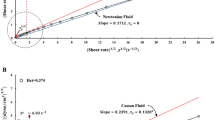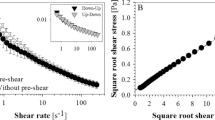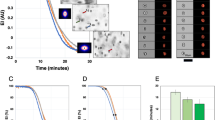Summary
The well known flow dependence of the optical density of whole blood was studied by measuring light transmission of blood in viscometric flow. A cone-plate chamber (3° cone angle) was transilluminated (λ=500–800 nm) while under shear (0–460 sec−1). The transmitted light was monitored with a selenium barrier layer photocell and was continuously recorded. In an identical chamber, the microrheological behaviour of the cells in flow was monitored by microphotography and then correlated to photometric events.
Light transmission of human blood showed a biphasic behaviour when plotted as a function of shear rate: between 0 and about 60 sec−1, the light transmission decreases with shear, corresponding to aggregate dispersion. Above 60 sec−1, an increase of light transmission with shear occurs, corresponding to red cell deformation, alignment, and orientation. Bovine blood, which does not form aggregates, shows minimum light transmission at rest. Light transmission then rises progressively with shear from the very onset of slow flow. Equine blood (equus zebra) which has very strong aggregation shows a progressive decrease of light transmission with shear due to aggregate persistence up to 460 sec−1. Amphibia blood (rana esculanta) shows very pronounced increase in light transmission at low shear rates, but no progression with shear. The nucleated amphibia erythrocytes are oriented but not deformed in flow. Rigidified cells which neither aggregate nor become oriented in flow show no flow dependent changes in light transmission. It became evident that in all blood samples minimum light transmission was recorded when the cells were dispersed and randomly oriented; both aggregation and orientation produced increased light transmission. These results explain earlier controversies in the literature, they shed doubt on the existence of a “tubular pinch effect” in whole blood rheology.
Similar content being viewed by others
References
Bloch, E. H.: High speed cinematography of the microvascular system. In: Hemorheology, Proc. 1st Intern. Conf., p. 655–667. A. L. Copley, ed. Oxford: Pergamon 1968.
Brinkman, R., Zijlstra, W. G., Jansonius, N. J.: Quantitative evaluation of the rate of rouleaux formation of erythrocytes by measuring light reflection (“Syllectometry”). Proc. kon. ned. Akad. Wet., Ser. C66, 237–248 (1963).
Chien, S., Usami, S., Dellenback, R. Y., Bryant, C. A.: Comparative hemoreology-hematological implications of species differences in blood viscosity. Biorhelogy8, 35–57 (1971).
Goldsmith, H. L., Mason, S. G.: The microrheology of dispersions. In: Rheology, theory and applications. F. R. Eirich, ed. New York: Academic Press 1967.
——: Deformation of human red cell in tube flow. Biorheology of human red cell in tube flow. Biorheology7, 235–242 (1971).
Jansonius, N. J., Zijlstra, W. G.: Various factors influencing rouleaux formation of erythrocytes, studied with the aid of syllectometry. Proc. kon. ned. Akad. Wet., Ser. C68, 122–127 (1965).
Kramer, K.: Ein Verfahren zur fortlaufenden Messung des Sauerstoffgehaltes im strömenden Blute an uneröffneten Gefäßen. Biol.96, 61–75 (1935).
Kurodo, K., Fujino, M.: On the cause of the increases in light transparency of erythrocyte suspensions in flow. Biorheology1, 167–182 (1963).
Mook, G. A., Osypka, P., Sturm, R. E., Wood, E. H.: Fibre optic reflection photometry on blood. Cardiovasc. Res.2, 199–209 (1968).
Nilsson, N. J.: Oximetry. Physiol. Rev.40, 1–26 (1960).
Ofstad, J.: The measurement of oxygen saturation and hemoglobin concentration by photometry of whole blood (chapt. IV) Bergen: A. S. John Griegs Boktrykker 1965.
Schmid-Schönbein, H.: Erythrocyte fluidity: Hemodynamic signification and methods of quantification in vitro. Proc. VI. Conf. on Microcirculation, Aalborg 1970 (in press).
—, Volger, E., Klose, H. J.: Microrheology and light transmission of blood. II. The photometric quantification of red cell aggreagate formation and dispersion in flow. Pflügers Arch.333, 140–155 (1972).
—, Wells, R. E.: Fluid drop-like transition of erythrocytes under shear. Science165, 288–291 (1969).
——: Rheological properties of human erythrocytes and their influence upon the “anomalous” viscosity of blood. Ergebn. Physiol.63, 145–219 (1971).
——, Schildkraut, R.: Microscopy and viscometry of blood flowing under uniform shear rate (rheoscopy). J. appl. Physiol.26, 674–678 (1969).
Segré, G., Silberberg, A.: The tubular pinch effect in the poiseuille flow of a suspension of sphères. Bibl. anat. (Basel)4, 83–93 (1961).
Taylor, M., Robertson, J. S.: The flow of blood in narrow tubes. I. A capillary microphotometer: an apparatus for measuring the optical density of flowing blood. Aust. J. exp. Biol.32, 721–732 (1954).
——: The flow of blood in narrow tubes. II. The axial stream and its formation as determined by changes in optical density. Aust. J. exp. Biol. med. Sci.33, 1–16 (1955).
Wells, R. E., Jr., Denton, R., Merrili, E. W.: Measurement of viscosity of biologic fluids by cone plate viscometer. J. Lab. clin. Med.57, 646–656 (1961).
Wever, R.: Untersuchungen zur Extinktion von strömendem Blut. Pflügers Arch. ges. Physiol.259, 97–109 (1954).
Wiederhielm, C. A., Billig, L.: Effects of erythrocyte orientation and concentration on light transmission through blood flowing through microscopic vessels. In: Hemorheology, Proc. 1st Intern. Conf. Reykjavic 1966. A. L. Copley, ed. Oxford: Pergamon Press 1968.
Yanami, Y., Intagliatta, M., Frasher, W. G., Wayland, H.: Photometric study of erythrocytes in shear flow. Biorheology2, 165–168 (1964).
Zijlstra, W. G., Heeres, S. G.: The influence of plasma substitutes on the suspension stability of human blood. Proc. kon. ned. Akad. Wet., Ser. C68, 413–422 (1965).
Author information
Authors and Affiliations
Additional information
Supported by grants from the Deutsche Forschungsgemeinschaft
Rights and permissions
About this article
Cite this article
Klose, H.J., Volger, E., Brechtelsbauer, H. et al. Microrheology and light transmission of blood. Pflügers Arch. 333, 126–139 (1972). https://doi.org/10.1007/BF00586912
Received:
Issue Date:
DOI: https://doi.org/10.1007/BF00586912




